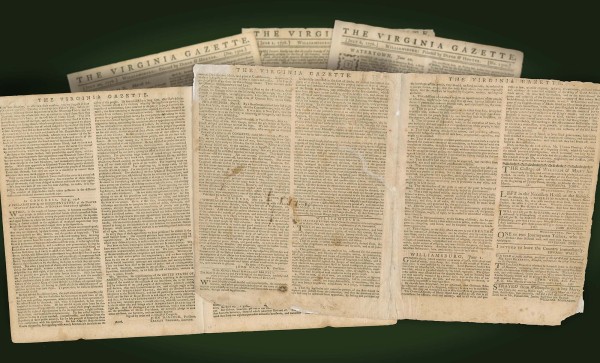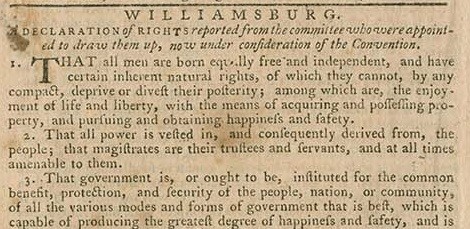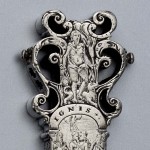
A new vodcast shows how the Paper Conservation Lab is protecting 1770s Virginia Gazettes.
You receive a copy of the first full printing of the Declaration of Independence in Virginia. It’s a true rarity. Only a handful of copies are known to still exist.
It’s seemingly in pretty good shape at 239 years and counting. But it’s laminated. It’s not exactly the thermal lamination long favored by schoolteachers all over, but it’s similar enough. William Barrow at the Library of Virginia developed this particular process to preserve important documents back in 1937.
It made sense at the time. It protected the paper from tearing or becoming soiled with handling. And Barrow was smart enough to make the process reversible. There was enough confidence from professional conservators that even a copy of the Emancipation Proclamation was laminated with the Barrow method.
But it turned out to be chemically unstable. Discoloration could occur, and in the worst case the chemical breakdown could cause “vinegar syndrome” as a document was exposed to acetic acid. As you might guess, a vinegar-ish smell is bad news when it’s in an archive.
So what do you do?
Well, for Colonial Williamsburg, you turn to the Conservation Lab. The Rockefeller Library had 86 early (and extremely rare) issues of Dixon & Hunter’s Virginia Gazette that were laminated.
That’s the bad news. The good news is that unlike pen and ink drawings that might be seriously damaged by the process, the Gazette was printed on pretty resilient stock.

Here it’s worth mentioning that there was more than one Virginia Gazette. In competition with each other, at the same time, in Williamsburg. The printers in charge changed many times, but in 1776 there were three: Dixon & Hunter’s, Purdie’s, and Pinkney’s.
When word of the Declaration of Independence came to Williamsburg in the third week of July, everyone rushed to be first. Pinkney published excerpts on July 19, but it was Dixon & Hunter who printed the whole text for the first time the next day. It is one of those that is currently being conserved.
Pam Young, the conservator of paper, selected Emily Overman, a graduate of Virginia Commonwealth University, for an internship focused on the Gazette conservation. The Marshall Steel Intern Fund paid for Emily’s work. In fact, the fund supports three or four conservation interns every year, ensuring that this work continues to be a strength for Colonial Williamsburg, and that the foundation’s expertise is shared with the next generation protecting our heritage.
The vodcast below explains the painstaking process Emily followed to conserve the Gazettes.
You might have noticed that these Virginia Gazettes are particularly small. They are perhaps 12 by 20 inches opened up. Wartime shortages caused many printers to be short of the materials need for paper. They frequently advertised “good prices paid for clean linen rags.” This Gazette seems to have been having difficulty acquiring paper. Witness the apology near the masthead below. The size of Purdie’s Virginia Gazette, however, seems not to have been affected.
There are other momentous events recorded on the pages of the newspapers being conserved.
The June 1, 1776 issue printed a draft of the Virginia’s Declaration of Rights that was being considered by the Fifth Virginia Convention, and would be passed officially on June 12. It was a direct influence on the drive for independence, and the bills of rights adopted by the states, and 15 years later as the first ten amendments to the Constitution.

The June 29 edition announced Patrick Henry’s election as the first governor of the independent colony of Virginia. That’s right, even before the Second Continental Congress meeting in Philadelphia even voted on the Declaration of Independence.
The Dec. 26, 1777 issue carries the motto: “The freedom of the press is one of the great bulwarks of liberty, and can never be restrained but by despotic governments.”
There are also everyday happenings: 18th-century help wanted ads, runaway slave notices, lost and found items, and more. Whether it’s high drama or everyday commerce, these morsels of history can transport us to a different time, and we’re the better for the journey.
Learn more about all the labs in Colonial Williamsburg’s Conservation Department.

Here’s Pam at the Burgess Socirty Lab visit showing an example of a print that has gone through the cleaning process. The Paper Lab is making an important contribution to the preservation of our documents. cf
Pam is doing a wonderful job in saving and preserving the documents that we hold so dear. I am delighted to see she is passing along her knowledge and techniques. Training and supporting internships is so important to preserve the past . Thank you Pam and the Conservation Programs. Nov. 2015 cf